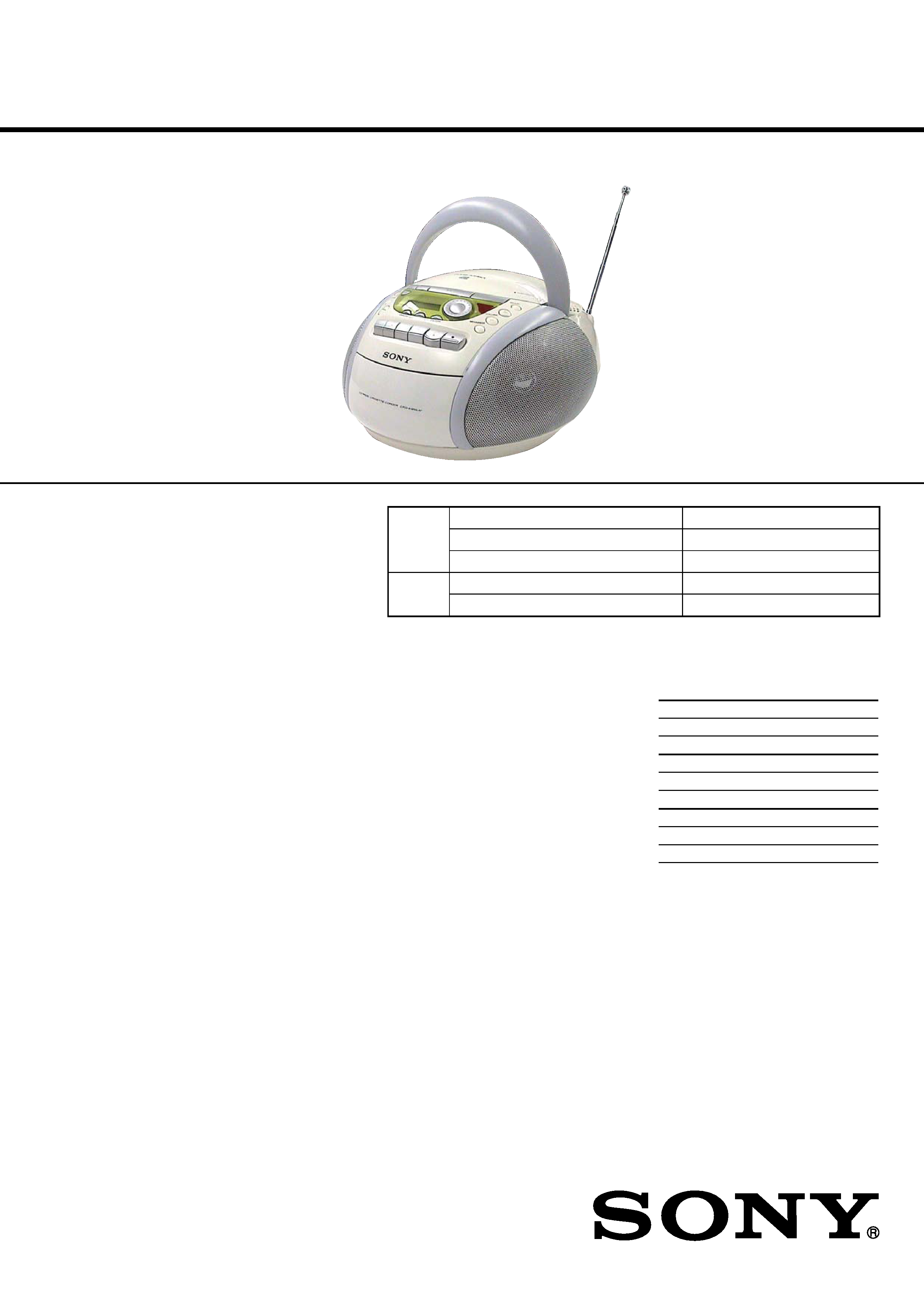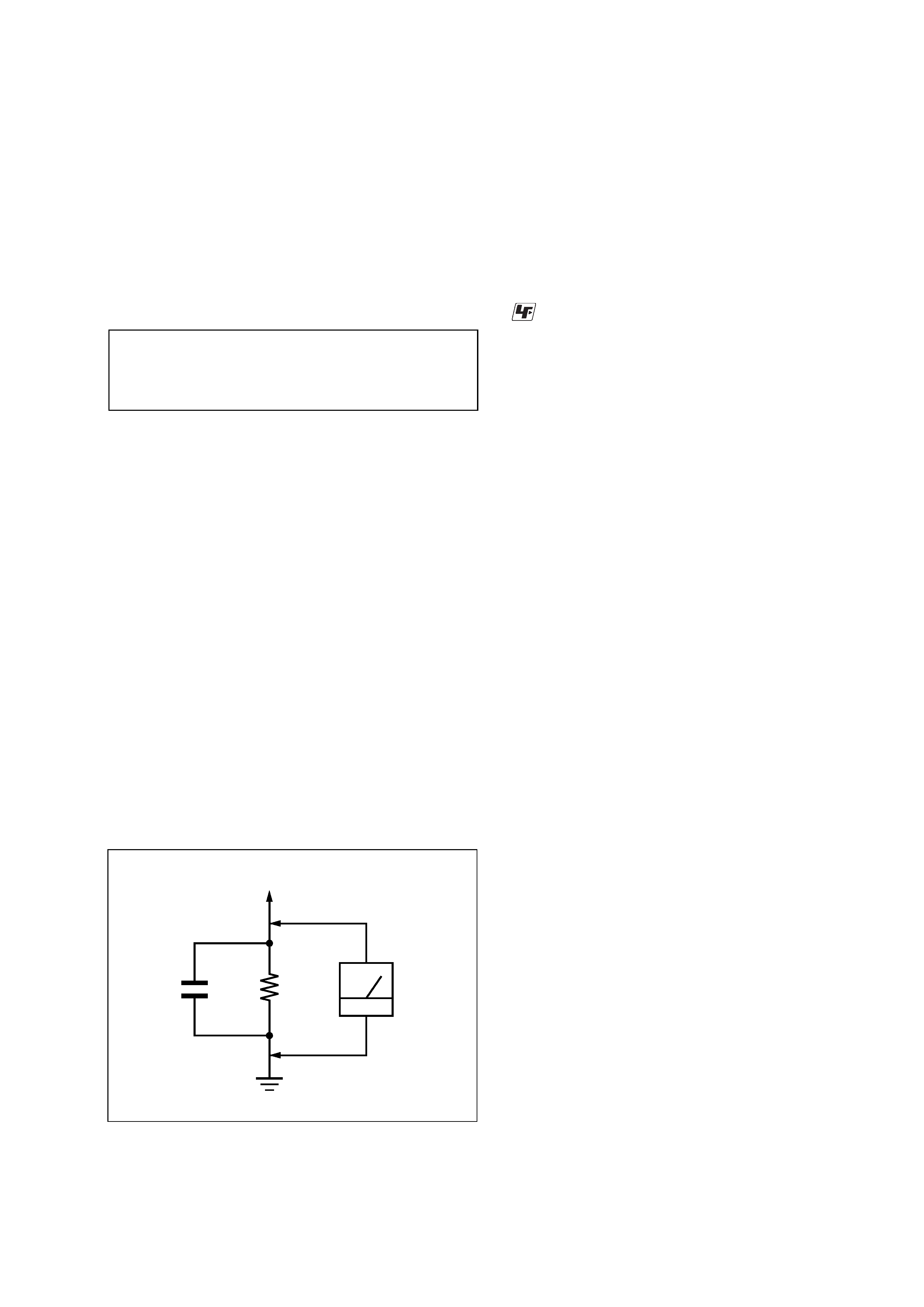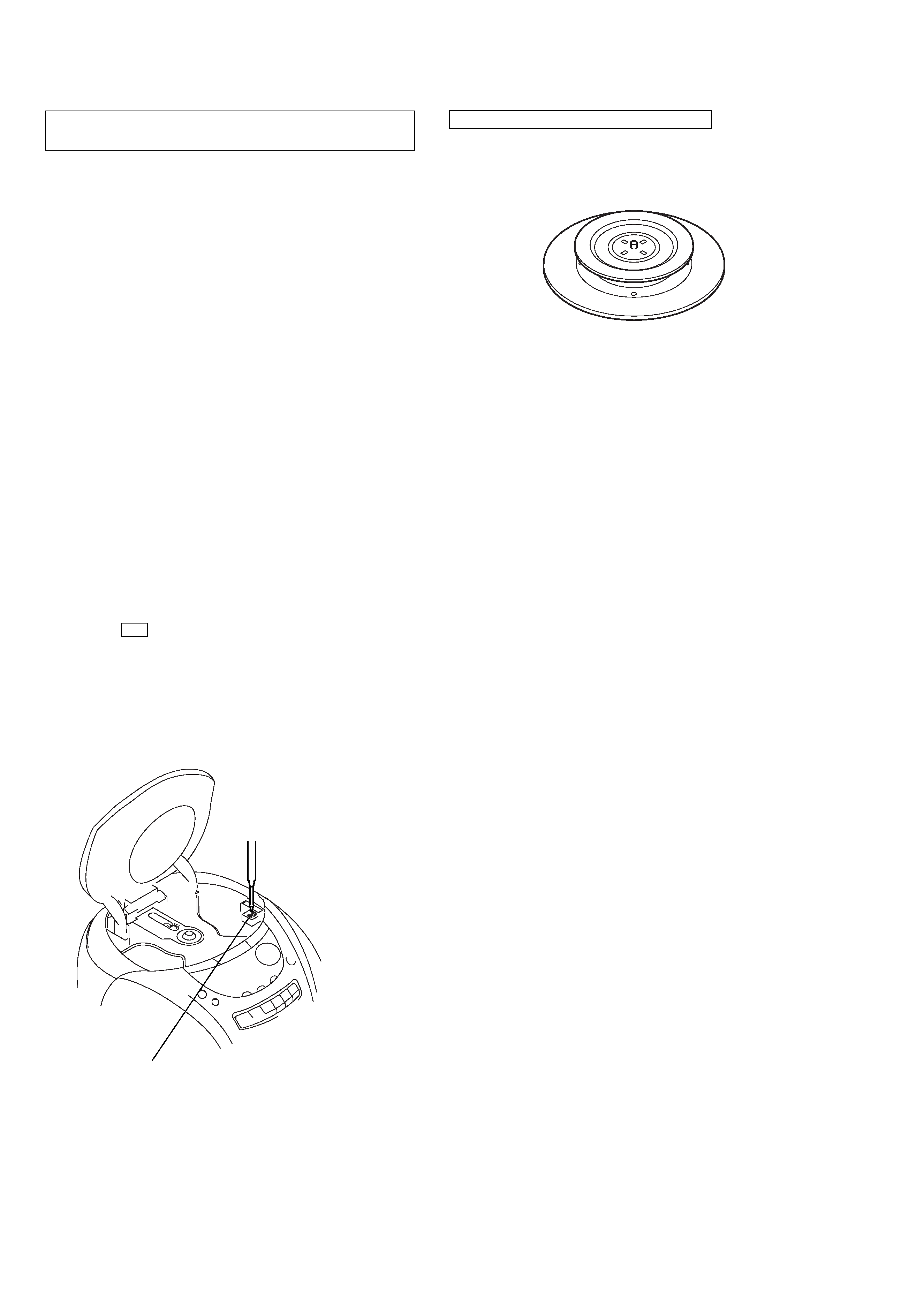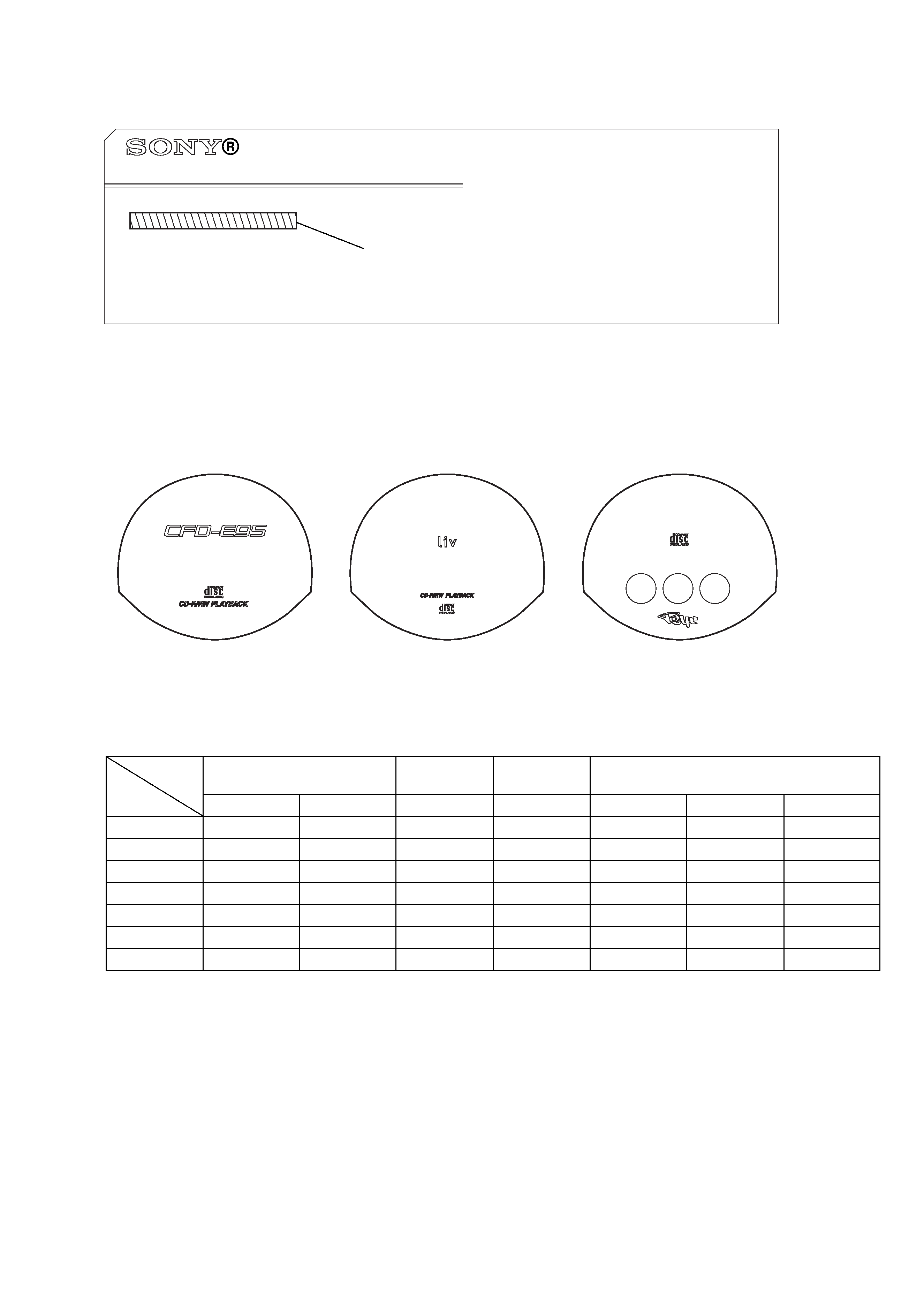
SERVICE MANUAL
CD RADIO CASSETTE-CORDER
US Model
Canadian Model
E Model
Australian Model
SPECIFICATIONS
CFD-E95
Ver. 1.3 2005.09
9-877-061-04
Sony Corporation
2005I05-1
Personal Audio Group
© 2005.09
Published by Sony Engineering Corporation
CD
Model Name Using Similar Mechanism
CFD-E75
Section
Optical Pick-up Block Name
KSM-213RDP or KSM-213CDP
Optical Pick-up Name
KSS-213R or KSS-213C
TAPE
Model Name Using Similar Mechanism
NEW
Section
Tape Transport Mechanism Type
MF-E95
AUDIO POWER SPECIFICATIONS
(US model only)
POWER OUTPUT AND TOTAL HARMONIC
DISTORTION
With 4-ohm loads, both channels driven from
100 - 10 000 Hz; rated 1.5 W per channel-
minimum RMS power, with no more than 10 %
total harmonic distortion in AC operation.
Other Specifications
CD player section
System
Compact disc digital audio system
Laser diode properties
Material: GaAlAs
Wave length: 780 nm
Emission duration: Continuous
Laser output: Less than 44.6
µW
(This output is the value measured at a distance of about
200 mm from the objective lens surface on the optical
pick-up block with 7 mm aperture.)
Spindle speed
200 r/min (rpm) to 500 r/min (rpm) (CLV)
Number of channels
2
Frequency response
20 - 20 000 Hz
Wow and flutter
Below measurable limit
Radio section
Frequency range
FM: 87.5 - 108 MHz
AM: 531 - 1 611 kHz (9 kHz step)
530 - 1 710 kHz (10 kHz step)
Antennas
FM: Telescopic antenna
AM: Built-in ferrite bar antenna
Cassette-corder section
Recording system
4-track 2 channel stereo
Fast winding time
Approx. 110 sec. with Sony cassette C-60
Frequency response
TYPE I (normal): 50 - 15 000 Hz
General
Speaker
Full range: 8 cm (3 1/4 in.) dia., 4
, cone type (2)
Outputs
Headphones jack (stereo minijack)
For 16 - 68
impedance headphones
Power output
1.8 W + 1.8 W (at 4
, 10 % harmonic distortion)
Power requirements
For CD radio cassette-corder
Except Singapore, Korean, Australian models:
120 V AC, 60 Hz
Korean model: 220 V AC, 60 Hz
Singapore, Australian models: 230 V AC, 50 Hz
9 V DC, 6 size C (R14) batteries
For memory back-up:
4.5 V DC, 3 size AA (R6) batteries
For remote control:
3 V DC, 2 size AAA (R03) batteries
Power consumption
AC 14 W
Battery life
For CD radio cassette-corder:
FM recording
Sony R14P: approx. 13.5 h
Sony alkaline LR14: approx. 20 h
Tape playback
Sony R14P: approx. 7.5 h
Sony alkaline LR14: approx. 15 h
CD playback
Sony R14P: approx. 2.5 h
Sony alkaline LR14: approx. 7 h
Dimensions
Approx. 272
× 164 × 285 mm (w/h/d)
(10 3/4
× 6 1/2 × 11 1/4 inches) (incl. projecting parts)
Mass
Approx. 3 kg (6 lb. 10 oz) (incl. batteries)
Supplied accessories
AC power cord (1)
Remote control (1)
Design and specifications are subject to change without
notice.

2
CFD-E95
TABLE OF CONTENTS
1.
SERVICING NOTES ..............................................
4
2.
GENERAL ..................................................................
6
3.
DISASSEMBLY
3-1. Disassembly Flow ...........................................................
9
3-2. Cabinet Upper Assy ........................................................
9
3-3. POWER Board ................................................................ 10
3-4. TUNER Board ................................................................. 10
3-5. MAIN Board ................................................................... 11
3-6. CD Mechanism Deck (KSM-213RDP) .......................... 11
3-7. Optical Pick-up (KSS-213R) .......................................... 12
3-8. Cabinet Front Section ..................................................... 12
3-9. Tape Mechanism Deck (MF-E95) .................................. 13
3-10. R/P Head (HRP301) ........................................................ 13
3-11. Main Belt (B), Sub Belt (B) ............................................ 14
3-12. CD Lid ............................................................................. 14
4.
MECHANICAL ADJUSTMENTS ...................... 15
5.
ELECTRICAL ADJUSTMENTS
Tape Deck Section ......................................................... 15
Tuner Section ................................................................. 16
CD Section ..................................................................... 18
6.
DIAGRAMS
6-1. Block Diagram CD Section .................................... 19
6-2
Block Diagram TUNER Section ............................ 20
6-3. Block Diagram MAIN Section ............................... 21
6-4. Block Diagram POWER SUPPLY Section ............ 22
6-5. Note for Printed Wiring Boards and
Schematic Diagrams ....................................................... 23
6-6. Printed Wiring Board CD Section .......................... 24
6-7. Schematic Diagram CD Section ............................. 25
6-8. Printed Wiring Board TUNER Section .................. 26
6-9. Schematic Diagram TUNER Section ..................... 27
6-10. Printed Wiring Board TAPE DECK Section .......... 28
6-11. Schematic Diagram TAPE DECK Section ............. 28
6-12. Printed Wiring Board MAIN Section ..................... 29
6-13. Schematic Diagram MAIN Section (1/2) ............... 30
6-14. Schematic Diagram MAIN Section (2/2) ............... 31
6-15. Printed Wiring Boards PANEL Section ................. 32
6-16. Schematic Diagram PANEL Section ...................... 33
6-17. Printed Wiring Boards POWER Section ................ 34
6-18. Schematic Diagram POWER Section .................... 35
6-19. IC Pin Function Description .......................................... 39
7.
EXPLODED VIEWS
7-1. Overall Section ................................................................ 41
7-2. Cabinet Front Section ..................................................... 42
7-3. Panel Section ................................................................... 43
7-4. LCD Board Section ......................................................... 44
7-5. MD Block Section ........................................................... 45
7-6. Cabinet Upper Section .................................................... 46
7-7. Cabinet Under Section .................................................... 47
7-8. Speaker Box Section ....................................................... 48
7-9. CD Block Section ........................................................... 49
7-10. Optical Pick-up Section (KSM-213RDP) ...................... 50
7-11. Tape Mechanism Deck Section (MF-E95) ..................... 51
8.
ELECTRICAL PARTS LIST .............................. 52

3
CFD-E95
SAFETY-RELATED COMPONENT WARNING!!
COMPONENTS IDENTIFIED BY MARK 0 OR DOTTED
LINE WITH MARK 0 ON THE SCHEMATIC DIAGRAMS
AND IN THE PARTS LIST ARE CRITICAL TO SAFE
OPERATION. REPLACE THESE COMPONENTS WITH
SONY PARTS WHOSE PART NUMBERS APPEAR AS
SHOWN IN THIS MANUAL OR IN SUPPLEMENTS PUB-
LISHED BY SONY.
CAUTION
Use of controls or adjustments or performance of procedures
other than those specified herein may result in hazardous ra-
diation exposure.
Notes on chip component replacement
·Never reuse a disconnected chip component.
· Notice that the minus side of a tantalum capacitor may be dam-
aged by heat.
Flexible Circuit Board Repairing
·Keep the temperature of the soldering iron around 270 °C dur-
ing repairing.
· Do not touch the soldering iron on the same conductor of the
circuit board (within 3 times).
· Be careful not to apply force on the conductor when soldering
or unsoldering.
SAFETY CHECK-OUT
After correcting the original service problem, perform the follow-
ing safety check before releasing the set to the customer:
Check the antenna terminals, metal trim, "metallized" knobs,
screws, and all other exposed metal parts for AC leakage.
Check leakage as described below.
LEAKAGE TEST
The AC leakage from any exposed metal part to earth ground and
from all exposed metal parts to any exposed metal part having a
return to chassis, must not exceed 0.5 mA (500 microamperes.).
Leakage current can be measured by any one of three methods.
1. A commercial leakage tester, such as the Simpson 229 or RCA
WT-540A. Follow the manufacturers' instructions to use these
instruments.
2. A battery-operated AC milliammeter. The Data Precision 245
digital multimeter is suitable for this job.
3. Measuring the voltage drop across a resistor by means of a
VOM or battery-operated AC voltmeter. The "limit" indica-
tion is 0.75 V, so analog meters must have an accurate low-
voltage scale. The Simpson 250 and Sanwa SH-63Trd are ex-
amples of a passive VOM that is suitable. Nearly all battery
operated digital multimeters that have a 2 V AC range are suit-
able. (See Fig. A)
Fig. A.
Using an AC voltmeter to check AC leakage.
1.5 k
0.15
µF
AC
voltmeter
(0.75 V)
To Exposed Metal
Parts on Set
Earth Ground
ATTENTION AU COMPOSANT AYANT RAPPORT
À LA SÉCURITÉ!
LES COMPOSANTS IDENTIFIÉS PAR UNE MARQUE 0
SUR LES DIAGRAMMES SCHÉMATIQUES ET LA LISTE
DES PIÈCES SONT CRITIQUES POUR LA SÉCURITÉ
DE FONCTIONNEMENT. NE REMPLACER CES COM-
POSANTS QUE PAR DES PIÈCES SONY DONT LES
NUMÉROS SONT DONNÉS DANS CE MANUEL OU
DANS LES SUPPLÉMENTS PUBLIÉS PAR SONY.
About CD-Rs/CD-RWs
This CD player can play CD-Rs/CD-RWs
recorded in the CD-DA format*, but
playback capability may vary depending on
the quality of the disc and the condition of
the recording device.
* CD-DA is the abbreviation for Compact Disc
Digital Audio. It is a recording standard used for
the Audio CDs.
: LEAD FREE MARK
Unleaded solder has the following characteristics.
· Unleaded solder melts at a temperature about 40 °C higher than
ordinary solder.
Ordinary soldering irons can be used but the iron tip has to be
applied to the solder joint for a slightly longer time.
Soldering irons using a temperature regulator should be set to
about 350 °C.
Caution: The printed pattern (copper foil) may peel away if the
heated tip is applied for too long, so be careful!
· Strong viscosity
Unleaded solder is more viscou-s (sticky, less prone to flow)
than ordinary solder so use caution not to let solder bridges oc-
cur such as on IC pins, etc.
· Usable with ordinary solder
It is best to use only unleaded solder but unleaded solder may
also be added to ordinary solder.

4
CFD-E95
SECTION 1
SERVICING NOTES
The laser diode in the optical pick-up block may suffer electro-
static break-down because of the potential difference generated
by the charged electrostatic load, etc. on clothing and the human
body.
During repair, pay attention to electrostatic break-down and also
use the procedure in the printed matter which is included in the
repair parts.
The flexible board is easily damaged and should be handled with
care.
NOTES ON LASER DIODE EMISSION CHECK
The laser beam on this model is concentrated so as to be focused
on the disc reflective surface by the objective lens in the optical
pick-up block. Therefore, when checking the laser diode emis-
sion, observe from more than 30 cm away from the objective lens.
LASER DIODE AND FOCUS SEARCH OPERATION
CHECK
During normal operation of the equipment, emission of the laser
diode is prohibited unless the upper lid is closed while turning ON
the S901. (push switch type)
The following checking method for the laser diode is operable.
· Method
Emission of the laser diode is visually checked.
1. Open the upper lid.
2. Push the S901 as shown in Fig.1.
Note: Do not push the detection lever strongly, or it may be bent or dam-
aged.
3. Press the u button.
4. Check the object lens for confirming normal emission of the
laser diode. If not emitting, there is a trouble in the automatic
power control circuit or the optical pick-up.
In this operation, the object lens will move up and down 2
times along with inward motion for the focus search.
NOTES ON HANDLING THE OPTICAL PICK-UP
BLOCK OR BASE UNIT
S901
Fig.1 Method to push the S901
CHUCK PLATE JIG ON REPAIRING
On repairing CD section, playing a disc without the CD lid, use
Chuck Plate Jig.
· Code number of Chuck Plate Jig: X-4918-255-1

5
CFD-E95
MODEL NO.
CFD-E95
US, Canadian, *E92, Taiwan models: AC: 120 V 60 Hz 14 W
Singapore, Australian models: AC: 230 V 50 Hz 14 W
Korean model: AC: 220 V 60 Hz 14 W
COLOR VARIATION
ORIGINAL TYPE
WALMART
LIV
PSYC TYPE
TYPE
TYPE
SILVER
BLUE
WHITE
WHITE
RED
BLUE
YELLOW
US
-
-
a
aaaa
CND
-
-
-
-
aa
-
E92
aa
-
----
SP
aa
-
----
AUS
aa
-
----
KR
aa
-
----
TW
aa
-
----
MODEL IDENTIFICATION
*E92: Central and South America model
The CFD-E95 is available with four types and seven defferent color variations.
How to identify the destination, type, and color variation is shown below.
· Abbreviation
AUS: Australian model
CND: Canadian model
E92: Central and South American model
KR: Korean model
SP: Singapore model
TW: Taiwan model
ORIGINAL TYPE
WALMART TYPE (US only)
LIV TYPE
(US only)
PSYC TYPE
(US, Canadian)
CD LID Top View
Ver 1.2
